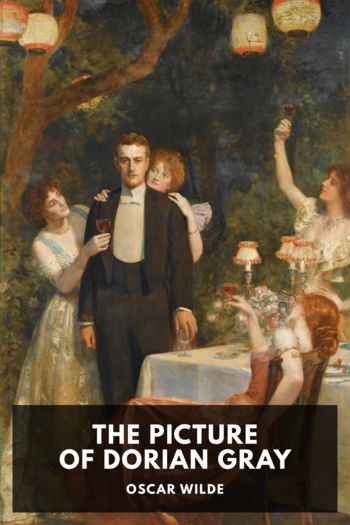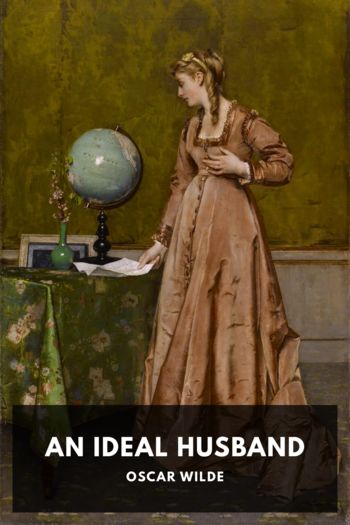The Picture of Dorian Gray by Oscar Wilde (top ebook reader TXT) 📕

Description
The Picture of Dorian Gray was first published as a serial in Lippencott’s Monthly Magazine, and the publishers thought it would so offend readers that they removed nearly 500 words without Wilde’s approval. Wilde soon expanded it and republished it as a novel, including a short preface justifying his art. Even though his contemporaries considered it so offensive that some argued for his prosecution, Dorian Gray today survives as a classic philosophical novel that explores themes of aestheticism and double lives. Couched in Wilde’s trademark cutting wit, Dorian Gray is still being adapted today, with Dorian and his moldering portrait remaining cultural touchstones.
Read free book «The Picture of Dorian Gray by Oscar Wilde (top ebook reader TXT) 📕» - read online or download for free at americanlibrarybooks.com
- Author: Oscar Wilde
Read book online «The Picture of Dorian Gray by Oscar Wilde (top ebook reader TXT) 📕». Author - Oscar Wilde
How exquisite life had once been! How gorgeous in its pomp and decoration! Even to read of the luxury of the dead was wonderful.
Then he turned his attention to embroideries and to the tapestries that performed the office of frescoes in the chill rooms of the northern nations of Europe. As he investigated the subject—and he always had an extraordinary faculty of becoming absolutely absorbed for the moment in whatever he took up—he was almost saddened by the reflection of the ruin that time brought on beautiful and wonderful things. He, at any rate, had escaped that. Summer followed summer, and the yellow jonquils bloomed and died many times, and nights of horror repeated the story of their shame, but he was unchanged. No winter marred his face or stained his flowerlike bloom. How different it was with material things! Where had they passed to? Where was the great crocus-coloured robe, on which the gods fought against the giants, that had been worked by brown girls for the pleasure of Athena? Where the huge velarium that Nero had stretched across the Colosseum at Rome, that Titan sail of purple on which was represented the starry sky, and Apollo driving a chariot drawn by white, gilt-reined steeds? He longed to see the curious table-napkins wrought for the Priest of the Sun, on which were displayed all the dainties and viands that could be wanted for a feast; the mortuary cloth of King Chilperic, with its three hundred golden bees; the fantastic robes that excited the indignation of the Bishop of Pontus and were figured with “lions, panthers, bears, dogs, forests, rocks, hunters—all, in fact, that a painter can copy from nature”; and the coat that Charles of Orleans once wore, on the sleeves of which were embroidered the verses of a song beginning “Madame, je suis tout joyeux,” the musical accompaniment of the words being wrought in gold thread, and each note, of square shape in those days, formed with four pearls. He read of the room that was prepared at the palace at Rheims for the use of Queen Joan of Burgundy and was decorated with “thirteen hundred and twenty-one parrots, made in broidery, and blazoned with the king’s arms, and five hundred and sixty-one butterflies, whose wings were similarly ornamented with the arms of the queen, the whole worked in gold.” Catherine de Medicis had a mourning-bed made for her of black velvet powdered with crescents and suns. Its curtains were of damask, with leafy wreaths and garlands, figured upon a gold and silver ground, and fringed along the edges with broideries of pearls, and it stood in a room hung with rows of the queen’s devices in cut black velvet upon cloth of silver. Louis XIV had gold embroidered caryatides fifteen feet high in his apartment. The state bed of Sobieski, King of Poland, was made of Smyrna gold brocade embroidered in turquoises with verses from the Koran. Its supports were of silver gilt, beautifully chased, and profusely set with enamelled and jewelled medallions. It had been taken from the Turkish camp before Vienna, and the standard of Mohammed had stood beneath the tremulous gilt of its canopy.
And so, for a whole year, he sought to accumulate the most exquisite specimens that he could find of textile and embroidered work, getting the dainty Delhi muslins, finely wrought with gold-thread palmates and stitched over with iridescent beetles’ wings; the Dacca gauzes, that from their transparency are known in the East as “woven air,” and “running water,” and “evening dew”; strange figured cloths from Java; elaborate yellow Chinese hangings; books bound in tawny satins or fair blue silks and wrought with fleurs-de-lys, birds, and images; veils of lacis worked in Hungary point; Sicilian brocades and stiff Spanish velvets; Georgian work, with its gilt coins, and Japanese Foukousas, with their green-toned golds and their marvellously plumaged birds.
He had a special passion, also, for ecclesiastical vestments, as indeed he had for everything connected with the service of the Church. In the long cedar chests that lined the west gallery of his house, he had stored away many rare and beautiful specimens of what is really the raiment of the Bride of Christ, who must wear purple and jewels and fine linen that she may hide the pallid macerated body that is worn by the suffering that she seeks for and wounded by self-inflicted pain. He possessed a gorgeous cope of crimson silk and gold-thread damask, figured with a repeating pattern of golden pomegranates set in six-petalled formal blossoms, beyond which on either side was the pineapple device wrought in seed-pearls. The orphreys were divided into panels representing scenes from the life of the Virgin, and the coronation of the Virgin was figured in coloured silks upon the hood. This was Italian work of the fifteenth century. Another cope was of green velvet, embroidered with heart-shaped groups of acanthus-leaves, from which spread long-stemmed white blossoms, the details of which were picked out with silver thread





Comments (0)